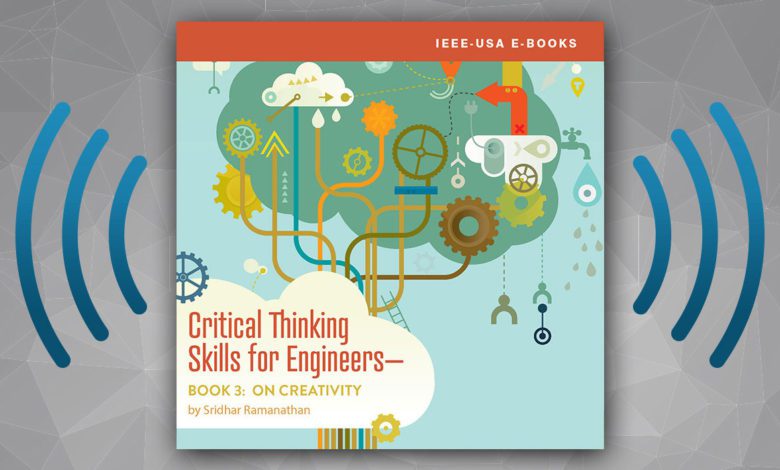
 In a new audiobook Critical Thinking Skills for Engineers – Book 3: On Creativity, author Sridhar Ramanathan states that many engineers are not, or at least do not consider themselves to be, creative. In this new audiobook release of his e-book, Ramanathan goes on to challenge that belief — and shows how one can become more creative; and in doing so, become a better engineer. The author sums up his view in the introduction: “Creativity is, indeed, within us all — and simply needs activation to overcome a long-held belief — that we, otherwise, are not creative.”
In a new audiobook Critical Thinking Skills for Engineers – Book 3: On Creativity, author Sridhar Ramanathan states that many engineers are not, or at least do not consider themselves to be, creative. In this new audiobook release of his e-book, Ramanathan goes on to challenge that belief — and shows how one can become more creative; and in doing so, become a better engineer. The author sums up his view in the introduction: “Creativity is, indeed, within us all — and simply needs activation to overcome a long-held belief — that we, otherwise, are not creative.”
This third audiobook in the Critical Thinking Skills for Engineering series builds upon the fundamentals of analytical skills and communication skills covered in earlier books; and it explores creative approaches for both individuals and groups.
The audiobook is chock full of useful exercises and ideas to foster creativity in the reader. Ramanathan delves into nine areas of creative thinking: divergent versus convergent thinking, cognitive flexibility, curiosity, abductive reasoning, visualization, abstract thinking, visionary thinking, imagination, and deferred critical thinking.
In each area, the author goes into specific practices; and he gives concrete suggestions the reader can act on to improve their ability to look at problems in more creative ways. He also discusses historical examples of a type of thinking allowed for better solutions of the problems at hand.
In the chapter on divergent vs convergent thinking, for instance, Ramanathan first defines divergent thinking as a “generation of as many ideas as possible for solutions to a given problem”; and he indicates that brainstorming is a recognized form of divergent thinking. The author then suggests two exercises that can help “stretch your creative muscle” in this area.
In the chapter on cognitive flexibility, Ramanathan outlines ways to stimulate flexibility in one’s thinking, giving such suggestions as:
- Learning new skills – such as learning a new language
- Changing routines – even as small an act as brushing your teeth with your alternate hand
- Practicing humor – he suggests reading Far Side cartoons for examples of incongruous juxtaposition of unrelated concepts, and to practice looking at things with a new view
- Improvisation – one engineer he cites resisted going to improv and then loved it — and was amazed by how it improved his creativity on the job
- Exercise – he notes several studies have shown that regular exercise can contribute to clearer, and more creative, thinking
- Challenging confirmation bias – always ask questions such as “What is possible, if I temporarily suspend my belief or preconceived notions?”
These types of concrete suggestions are found in every chapter. They are rounded out with examples from history to illustrate a point. In the chapter on abductive reasoning (developing an explanation for a partial data set), the author gives the example of scientists using abductive reasoning to come up with multiple explanations for Uranus’ orbital wobble. He points out that it would take decades to discern which hypothesis was correct.
In another chapter, Ramanathan illustrates how creatively looking at something one uses every day can lead to new and better products. He gives the example of how Jamie Siminoff came up with the Ring Video Doorbell.
Another example the author offers is Tesla’s development of its “iPod-like” dashboard — and how breaking away from the traditional button-driven dash allowed it not only to be more creative and effective in giving information, but also allowing the dashboard to evolve to meet changing customer needs. These changes can be delivered with simple computer updates (delivered overnight, while a car is charging), as opposed to only making changes when a car model is redesigned.
This audiobook, along with the previous audiobooks in the series, are available for free at IEEE-USA’s online shop at: https://ieeeusa.org/product-tag/critical-thinking-skills/.
Ramanathan is an advocate for engineers developing their creative skills as seriously as they might develop other more traditional engineering skills. This book is ideal for the engineer who is looking for exercises and suggestions that will help them unleash their creativity.
In addition to thirty years of experience in technology, including cofounding and serving as managing director of the Aventi Group, Ramanathan fosters his own creativity by being active in nonprofit work, from Boy Scouts to St. Michael’s church ministries to serving as Vice Chair Emeritus of the Board of Child Advocates of Silicon Valley — an organization that provides stability and hope to abused and neglected children.
Paul Lief Rosengren is the coauthor of In the Time of Covid: One Hospital’s Struggles and Triumphs. He worked for more than three decades in corporate communications and in state government. He has a Master’s in Public Policy from The Kennedy School of Government, Harvard and an undergraduate degree in political science from Dickinson College.






